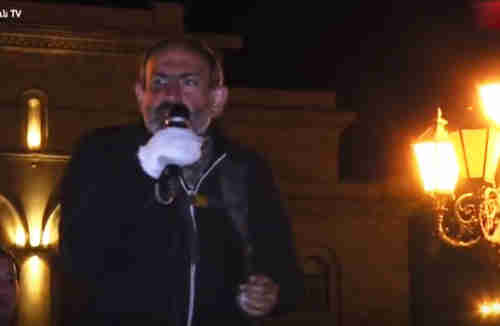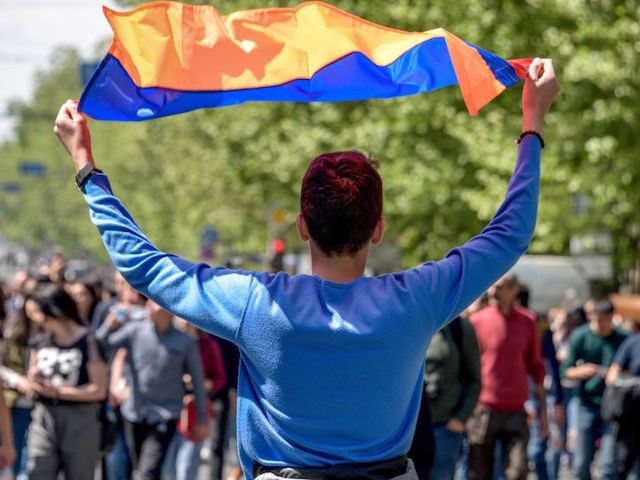This morning’s key headlines from GenerationalDynamics.com
- Leader of Armenia’s ‘non-violent velvet revolution’ threatens to paralyze the country
- Brief generational history of Armenia, Turkey and Azerbaijan
Leader of Armenia’s ‘non-violent velvet revolution’ threatens to paralyze the country

Nikol Pashinyan, late Tuesday evening, calling for his supporters on Wednesday to block buildings and roads. The violence gave him a black eye, and there is some blood on his bandaged right hand. (lragir.am)
Nikol Pashinyan, a member of Armenia’s parliament from the opposition Yelk party, is calling for a “non-violent velvet revolution,” alluding to the peaceful 1989 uprising that ousted the Communist regime in the former Czechoslovakia. Pashinyan’s objective is to prevent Serzh Sargsyan, who has served ten years as Armenia’s president, from continuing in power as Armenia’s prime minister under a new constitution.
Protesters are particularly incensed that Sargsyan had promised not to run for prime minister after the constitution was changed, but now is running anyway.
With protesters chanting “Serzh the liar,” Pashinyan has been calling for widespread strikes and blockades of streets and government buildings in Armenia’s capital city Yerevan, with the objective of preventing the parliament from voting to make Sargsyan the prime minister.
There were widespread protests across several cities, with students blocking roads and buildings. At least 46 people were injured in the protests, including six police officers. More than 60 people were arrested. Pashinyan himself was taken to a hospital with cuts and an eye injury, but he returned to speak to the crowd and urge further protests.
On Tuesday, the parliament voted overwhelmingly, 76 to 17 with no abstentions, to elect former president Sargsyan as the prime minister under the new constitution.
Late on Tuesday, Pashinyan addressed the crowd and called for widespread protests to block government agencies, streets and highways.
Tomorrow at 10 am, I will be waiting for you on France Square where our actions will start and will be concluded on Republic Square.
…
On the upcoming days we will form velvet revolution committees which will lead this movement till victory. Revolutionary committees will be created in all areas and regions of the country. Very soon all the government agencies of Armenia, including the police will have to perform the orders of the revolutionary committees, not of Serzh Sargsyan.
Tomorrow morning we must paralyze entire Armenia, from the 9th district to 3rd, 4th villages. Serzh Sargsyan and his servants must not have room to move in Yerevan, they must move along the crossing points that we will decide. Tomorrow we set up crossing points in Yerevan streets which are intended for the Republicans and their riffraff only.
RFE/RL and Lragir (Armenia) and News (Armenia) and NPR
Brief generational history of Armenia, Turkey, and Azerbaijan
Armenia had two generational crisis wars, over 70 years apart, during the 20th century.
The first occurred during World War I between 1915-17, when over a million Armenians were massacred and deported from their homeland in Anatolia (Turkey) to present-day Syria. Armenia considers the killings genocide, a charge that Turkey denies.
The second generational crisis war was the conflict between 1989-94 with Azerbaijan over the enclave Nagorno-Karabakh. Nagorno-Karabakh is an Armenian-occupied region within Azerbaijan and the source of continuing conflict between Armenia and Azerbaijan.
Today, Armenia is in a generational Awakening era, one generation past the end of the previous generational crisis war. Student protests are common in Awakening eras (as in America and Europe in the 1960s) because this is the coming of age of the first generation growing up after the crisis war. So the student protests occurring this week in Armenia are typical of this era.
Although the war between Armenia and Azerbaijan was an external war, more research is needed on the question of the extent to which it was also an ethnic conflict between the ethnic Armenians and the ethnic Turkic population of Azerbaijan.
During this week’s protests, with the objective of preventing former president Serzh Sargsyan from becoming prime minister, opposition leader Nikol Pashinyan said the following:
Serzh Sargsyan is trying to change the essence of our country. He’s transforming it into western Azerbaijan. We aren’t citizens of Azerbaijan. We are citizens of Armenia. We aren’t citizens of North Korea or of Kazakhstan.
Media sources do not explain what Pashinyan means by “transforming it into western Azerbaijan.” This suggests an ethnic issue and requires more research. Hetq (Armenia) and BBC
Related articles:
- Turkey, Armenia hold dueling WW1 centennials over genocide and Gallipoli (25-Apr-2015)
- Armenia-Azerbaijan escalating conflict in Nagorno-Karabakh threatens the entire region (03-Apr-2016)
- Azerbaijan faces rising radical Shia Islamist insurgency (07-Dec-2015)
- Armenia says it’s ‘ready for war’ with Azerbaijan ‘bastards’ (04-Sep-2012)
KEYS: Generational Dynamics, Armenia, Serzh Sargsyan, Nikol Pashinyan, Czechoslovakia, Turkey, Azerbaijan, Nagorno-Karabakh
Permanent web link to this article
Receive daily World View columns by e-mail

COMMENTS
Please let us know if you're having issues with commenting.